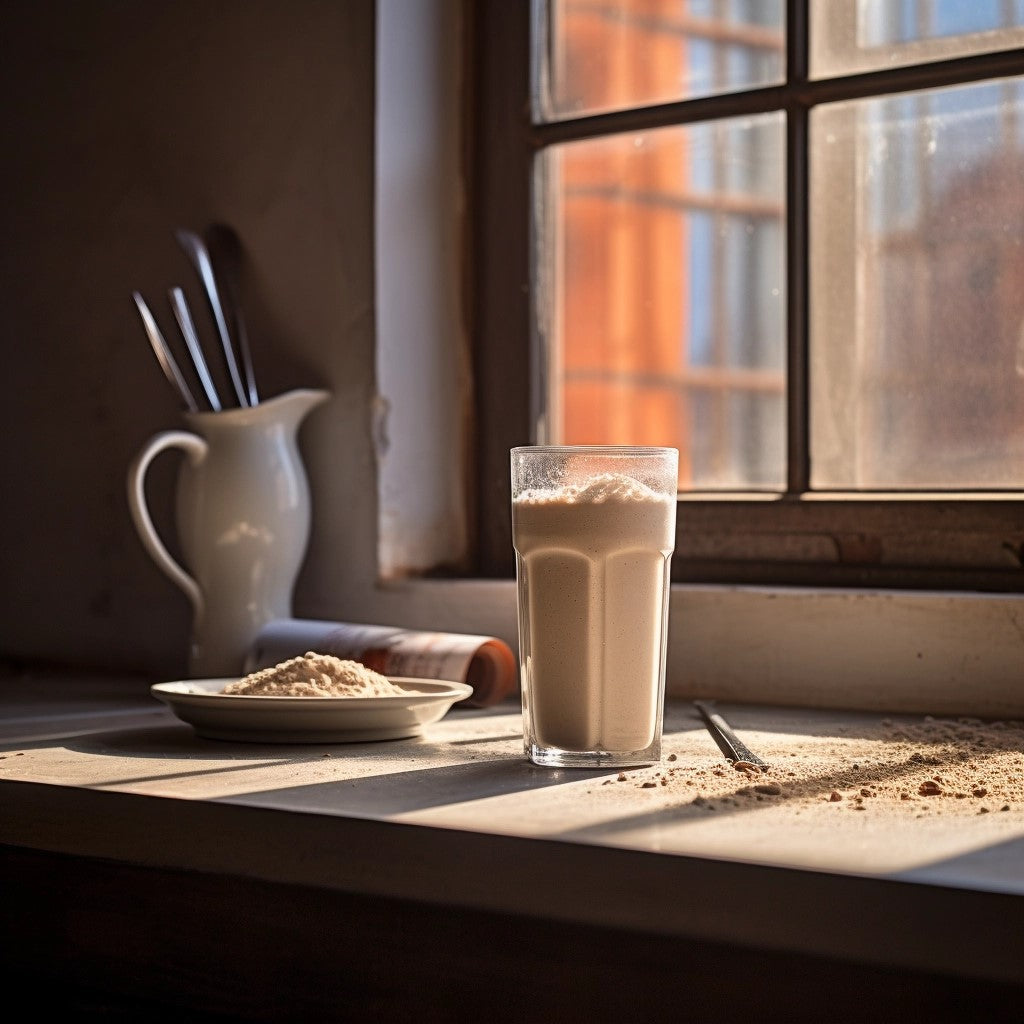The benefits of protein are many, from maintaining lean muscle mass to promoting recovery after intense workouts.
But how do we ensure we’re getting enough?
Enter protein shakes! A convenient, delicious way to meet our daily protein requirements.
Whether you’re a gym enthusiast, a busy professional, or just someone looking for a nutritious boost, protein shakes can be a game-changer in your diet.
Perfect Pairings: Liquid Bases for Your Protein Powder
The choice of liquid significantly influences the process of mixing protein powder.
Not only does it impact the taste and texture, but also adds to the overall nutritional value of your shake.
From the creamy goodness of almond milk to the refreshing hydration of coconut water to the coffee-infused kickstart, there’s a plethora of choices available for everyone’s palate.
1. Almond Milk
Almond milk has emerged as a popular alternative to dairy milk, offering a creamy texture and additional nutrients.
Not only does it enhance the texture of protein shakes, but it also brings in a subtle nutty flavor that complements various protein powders exceptionally well.
Be it whey isolate or vegan vanilla protein powders, almond milk pairs beautifully with them all.
Eager to try something new? Try creating a protein parfait yogurt by layering yogurt, fruit, and your favorite protein powder.
The result?
A protein-enriched treat to energize your day!
2 Coconut Water
Coconut water isn’t just a refreshing tropical beverage; it’s also a fantastic base for your protein shakes.
Loaded with essential electrolytes, it’s particularly beneficial post-exercise for replenishing fluids and promoting muscle recovery.
For a creamier texture, you can also try using coconut milk as an alternative.
Pair it with banana cream pie protein powder for a delicious shake that’s sure to please your taste buds.
You are also welcome to try inventive recipes such as the Blueberry Coconut Protein Smoothie or the Gone Bananas Smoothie, in which protein powder, coconut water, and fruit unite to form a nutrient-rich blend.
3. Coffee
For the coffee lovers out there, how about adding a protein punch to your morning cup of joe?
Mixing protein powder with coffee can potentially result in improved workout performance and support muscle growth.
Vanilla and chocolate protein powders mix well with coffee, giving it a delicious taste and a nutritional boost.
And if you’re concerned about achieving a smooth texture, a shaker bottle or blender can come to the rescue.
How about a latte protein shake?
Simply mix protein powder with your favorite coffee for a delicious and nutritious treat.
Creative Combos: Mix-Ins for Flavor and Nutrition
A protein shake doesn’t have to be a monotonous blend of powder and milk. With a bit of creativity, it can transform into a culinary masterpiece that’s both delicious and nutritious. The secret lies in your mix-ins! Fruits, nut butters, seeds - the possibilities are endless. Each brings its unique taste and nutrition profile to the table, not to mention a burst of color to make your shake instagrammable.
1. Fruit Fusions
Fruits can add a natural sweetness to your protein shake, making it more enjoyable while packing in a range of nutrients. Some options include:
- Tangy raspberries
- Blueberries
- Sweet bananas
- Peaches
The variety is endless. The best part? You can use fresh or frozen fruits, depending on your preference.
Incorporate some ice for an extra cooling effect, and you’ve created a fruit-infused protein shake that’s both invigorating and satiating.
2. Nut Butter Bliss
If you’re a fan of that creamy, nutty goodness, adding nut butter to your protein shake is a must-try.
Nut butters not only give your shake a rich texture, but they also provide added flavor and a source of healthy fats.
Whether it’s peanut butter, almond butter, or hazelnut butter, each one enhances the overall nutritional value of your shake.
Thus, remember to include a scoop of your preferred nut butter the next time you prepare your shake!
3. Seed Sensations
Seeds like chia and flax are tiny powerhouses of nutrition that can take your protein shake to the next level.
They boost the fiber content, provide healthy fats, and even lend a unique texture to your shake.
Chia seeds create a gel-like consistency, while flax seeds provide a smoother texture, making your shake not just nutritious, but also fun to drink.
Feel free to sprinkle in some seeds and provide your protein shake with a nutrition-enriched transformation!
Protein-Packed Meals: Beyond the Shake
Protein powders, such as vanilla protein powder, are not just limited to shakes. They can be a versatile addition to your culinary adventures, finding their way into breakfast dishes, savory meals, and even desserts. To diversify your diet, simply add protein powder mixed to various recipes.
1. Breakfast Reimagined
Starting your day with a protein-rich breakfast can keep you satiated for longer and provide the energy you need to tackle the day ahead.
How about some protein pancakes or waffles for breakfast? Or perhaps a smoothie bowl sprinkled with protein powder?
These dishes are not only delicious but also pack a protein punch to kickstart your day.
2. Savory Selections
Who said protein powders only belong in sweet dishes?
They can also be a part of your savory dishes, providing a protein boost without altering the taste. Here are some ways to incorporate protein powder into your meals:
- Protein-packed burgers
- Lasagna with a protein twist
- Protein-infused soups
- Protein pancakes
- Protein smoothies
Try these recipes and enjoy the benefits of protein in your savory meals!
Feel free to experiment with your preferred dishes and relish your protein in novel and thrilling methods!
3. Sweet Endings
And now, for all the sweet tooths out there, protein powders can also find their way into your favorite desserts!
You can make protein brownies, cookies, and even ice cream using chocolate protein powder.
These desserts not only satisfy your sweet cravings but also provide a good dose of protein.
Next time you have a sweet craving, there’s no need for guilt. Simply incorporate some protein powder and savour the treat!
Specialized Shakes: Tailoring to Your Dietary Needs
Everybody is unique, and so are their dietary needs. Whether you’re lactose intolerant, trying to gain weight, or following a low-carb diet, there’s a protein shake that fits your needs.
1. Lactose-Free Options
If you’re lactose intolerant or prefer to avoid dairy, you can still enjoy protein shakes.
There are lactose-free protein powders and non-dairy milk alternatives that you can use to mix your shake.
Whether you prefer almond milk, coconut water, or rice milk, there’s an array of options to choose from.
Rest assured! You can still relish your protein shake without any discomfort.
2. High-Calorie Helpers
For those looking to gain weight or support intense workouts, high-calorie protein shakes can be a great option.
By adding ingredients like nut butters, whole milk, and avocados, you can increase the calorie content of your shake.
These shakes are not just high in calories, but also packed with nutrients to fuel your body.
3. Low-Carb Choices
If you’re on a low-carb diet, you can still enjoy protein shakes. Here’s how:
- Use unsweetened almond milk as the base
- Focus on adding healthy fats and fiber to your shake
- Choose a low-carb protein powder to meet your protein intake
By following these tips, you can make a delicious, low-carb protein shake without compromising your diet.
Tools of the Trade: Getting the Perfect Blend
Creating the perfect protein shake is an art, and like every artist, you need the right tools and techniques to create your masterpiece.
The Right Equipment
Investing in a good-quality blender or shaker bottle can make a world of difference in the quality of your protein shakes.
A high-quality blender can blend your protein powder smoothly, ensuring there are no clumps.
And if you’re on the go, a shaker bottle can be your best friend, letting you mix your protein shake anytime, anywhere.
Smoothie Secrets
If you’re tired of lumpy, unappetizing protein shakes, these smoothie secrets can help. Start by adding liquid before the powder to avoid clumping.
Also, breaking up any clumps in the powder before mixing can give you a silky-smooth shake.
Feel free to utilize these tips for a smoother, more delicious protein shake!
Ice, Ice, Baby
Want to take your protein shake to the next level? Add some ice! Ice not only cools down your shake but also gives it a thicker consistency.
And if you want to add some extra flavor, try using frozen fruit instead of ice. From frozen berries to bananas, there’s a whole range of fruits you can freeze and use in your shakes.
Remember to include ice next time you prepare a protein shake!
Meal Replacement Mastery: When to Substitute with a Shake
While protein shakes are a great way to supplement your diet, they can also serve as a convenient meal replacement.
But when should you substitute a meal with a shake?
The answer lies in balancing macronutrients, timing, and portion control.
Balancing Macronutrients
A well-balanced meal replacement shake should contain a good mix of protein, carbohydrates, and healthy fats.
This ensures your body gets all the nutrients it needs and keeps you satiated for longer.
From adding honey for carbs to including avocado for healthy fats, there are various ways to achieve this balance in your protein shake.
Timing is Everything
The timing of your protein shake can have a significant impact on its effectiveness.
Consuming a protein shake post-workout can enhance muscle recovery, while starting your day with a protein shake can boost your metabolism.
So, before you gulp down that shake, ensure the timing is right!
Portion Control
Portion control is key when using protein shakes as meal replacements. Overdoing it can lead to excessive calorie intake, which can counteract your weight management efforts.
So, while protein shakes are a convenient and nutritious meal replacement, always remember - moderation is key!
The Science of Supplementation: Understanding Protein Intake
Now that we’ve explored the practical aspects of protein shakes, let’s delve into the science of protein supplementation.
Understanding the role of protein in muscle building, the recommended intake, and the differences between whey and plant-based protein powders can help you make informed choices.
Building Blocks of Muscle
Protein is a key player in muscle growth and repair. When you exercise, especially resistance training like weightlifting, protein synthesis in the muscles is stimulated.
This promotes muscle repair and growth, helping you achieve those fitness goals faster.
If you’re regularly working out, a protein shake can be your greatest companion!
Quantity Quandaries
Determining the right amount of protein can be a bit of a quandary. The general recommendation is 0.8 grams of protein per kilogram of body weight per day.
However, factors like your activity level and dietary preferences can influence this number. Hence, consulting a nutritionist or a health professional is always recommended for determining your appropriate protein intake.
Whey vs. Plant-Based
In the world of protein powders, whey protein powder and plant-based powders are two popular choices.
While whey protein boasts higher bioavailability, plant-based proteins offer a nutrient-dense profile with a significant iron content.
Whether you select whey or plant-based proteins, it ultimately depends on your individual dietary needs and inclinations.
Summary
We’ve taken a deep dive into the world of protein shakes, exploring different liquid bases, creative mix-ins, meal replacements, and even the science behind protein intake.
Whether you’re a fitness enthusiast, a busy professional, or just someone looking for a nutritious snack, protein shakes can be a convenient and delicious way to meet your daily protein requirements.
Remember, the key to a perfect protein shake lies in customization - choose your base, add your mix-ins, and tailor it to your dietary needs.





